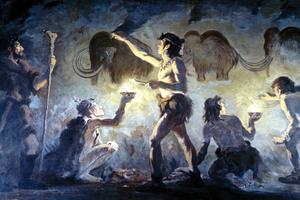Eating, Drinking and Praying — G.K. Chesterton and Christmas
Chesterton had the good sense to treat Christmas as if it were the very center of history

The author most associated with the joy and glow of Christmas is obviously Charles Dickens. Apart from the perennially popular A Christmas Carol, Dickens wrote several other Christmas-themed novellas, most notably The Chimes and The Cricket and the Hearth. In his book on Dickens, in a chapter entitled “Dickens and Christmas,” G. K. Chesterton lauded “Dickens’s great defence of Christmas”:
In fighting for Christmas he was fighting for the old European festival, Pagan and Christian, for that trinity of eating, drinking and praying which to moderns appears irreverent, for the holy day which is really a holiday.
Chesterton wrote that “the great furnace of real happiness that glows through Scrooge and everything around him” had its source in “that great furnace, the heart of Dickens”:
Whether the Christmas visions would or would not convert Scrooge, they convert us. Whether or no the visions were evoked by real Spirits of the Past, Present, and Future, they were evoked by that truly exalted order of angels who are correctly called High Spirits. … The story sings from end to end like a happy man going home. … It is lyric and exclamatory, from the first exclamatory words of it. It is strictly a Christmas carol.
If Chesterton paid homage to the Dickensian spirit of Christmas, it would be true to say that he also contributed something truly special to the literary glow of the season. This Chestertonian spirit of Christmas is truly as worthy of celebration as is its Dickensian counterpart.
Chesterton wrote a great deal about Christmas, some of which is of questionable quality, including several mostly mediocre poems, such as “The Nativity,” “A Christmas Carol,” “Joseph” and “The Wise Men.” He is much better when he evokes the poetry of the season in the poetic prose and whimsical wit of his wonderful essays. “There is no more dangerous or disgusting habit than that of celebrating Christmas before it comes, as I am doing in this article,” he wrote in “Christmas that is Coming.” He would indulge this “dangerous and disgusting habit” on numerous occasions. He wrote of Christmas ballads, and turkey, and Christmas pudding. He waxed lyrical on “The Theology of Christmas Presents,” on “Christmas and the Professors” and on “Some Fallacies and Santa Claus.” He lamented “The Modern Scrooge” and toasted “The Winter Feast.”
Never one to be constrained by any particular literary genre, Chesterton celebrated Christmas in the writing of a mummer’s play, “The Turkey and the Turk,” which contained both Father Christmas and St. George amongst its festive array of characters. He also wrote a truly wonderful short story, “The Shop of Ghosts,” in which Father Christmas is cast as the owner of a toy shop visited by ghosts from across the centuries, including Charles Dickens, Sir Richard Steele, Ben Jonson, and finally Robin Hood. These ghosts of Christmases Past witness to the perennial place of Father Christmas, a symbol of Christmas itself, in the hearts of countless generations of merry gentlemen who had let nothing them dismay, in the sure and certain knowledge that Jesus Christ their Savior was born on Christmas Day.
The perennial relevance of Christmas was treated with less levitas and greater gravitas in what is arguably Chesterton’s greatest book, The Everlasting Man. In this seminal work, an outline of human history intended as a riposte to, and a rebuttal of, the chronological snobbery of H. G. Wells’s Outline of History, Chesterton places Christmas, or more specifically the Incarnation, at the very center of history. Part One of Chesterton’s book, “On the Creature Called Man,” begins with a chapter called “The Man in the Cave”; Part Two, “On the Man Called Christ,” begins with a chapter called “The God in the Cave.” The point and purpose of such a structuring of history is to show that the whole of history prior to Christ, from the prehistoric “caveman” onwards, was the ripening of humanity for the coming of the One who could save humanity from itself. “God also was a Cave-Man,” Chesterton wrote, “and had also traced strange shapes of creatures, curiously coloured, upon the wall of the world; but the pictures that he made had come to life.”
In the Coming of Christ at Christmas, we see the Artist of all Creation entering his own masterpiece and we see the storyteller entering his own story, history being ultimately His Story. It is in this sense that Chesterton, in the final stanza of “A Christmas Carol,” places the Christ Child at the center of the cosmos:
The Christ-Child stood at Mary’s knee,
His hair was like a crown,
And all the flowers looked up at Him,
And all the stars looked down.
This article first appeared in the UK’s Catholic Herald and is republished with permission.
- Keywords:
- g.k. chesterton
- Charles dickens
- christmas

















